#aviraptor
Text

ITS TIME
FOR
DINOSAUR MARCH MADNESS 2k23!!!!!!!!!!!!
Starting NEXT WEEK, we begin the ultimate competition:
DMM: RISING STARS
These are ALL dinosaurs that have been discovered in the past five years!!! New friends from old times!!! Including such new fan favorites as Bajadasaurus, Jakapil, Meraxes, and Anachronornis - and that's only four of them!
From the weird to the wonderful, these dinosaurs are here to indicate that just because they were found recently, doesn't mean that they aren't destined to become icons like the names we already know and love. Get ready to learn about some new paleontological excitement - and debate angrily over which ones are better ;)
Round One will go from March 1st through the 7th
Round Two will extend from March 8th through the 14th
Round Three will then go from the 15th to the 21st
Round Four from the 22nd to the 28th
And the FINAL FOUR SHOWDOWN (Ornithischian Vs Sauropodomorph vs Nonavian theropod vs Bird) will occur from March 29th through April 4th!
Thanks to the new tumblr poll feature, reconstructions and mini factfiles for each dinosaur will be on the post with the poll itself! No need to leave tumblr, no personal research, no google quizzes - just rapid learning and immediate voting!
Get ready to vote! Get ready to debate! Get ready... for DINOSAUR MARCH MADNESS!
Round One Matchups under the readmore :)
SAUROPODOMORPHA (and miscellany)
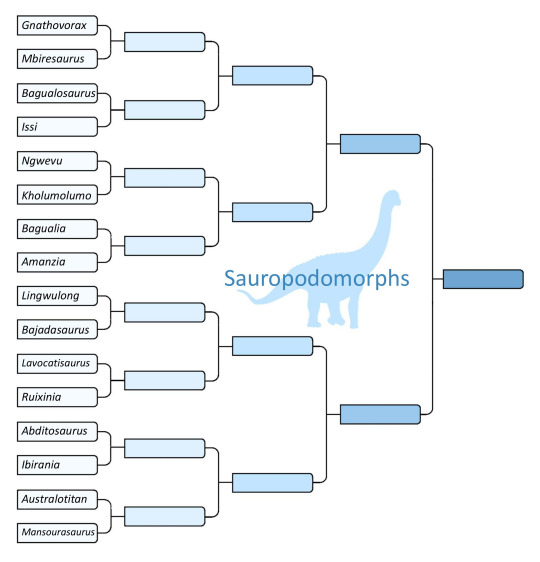
Gnathovorax vs Mbiresaurus
Bagualosaurus vs Issi
Ngwevu vs Kholumolumo
Bagualia vs Amanzia
Lingwulong vs Bajadasaurus
Lavocatisaurus vs Ruixinia
Abditosaurus vs Ibirania
Australotitan vs Mansourasaurus
ORNITHISCHIA
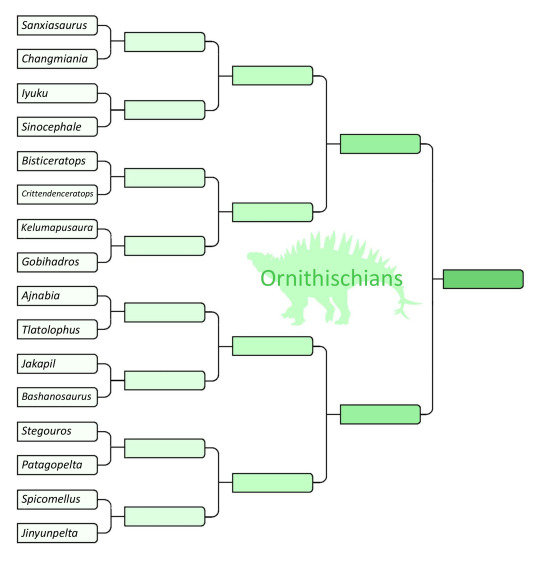
Sanxiasaurus vs Changmiania
Iyuku vs Sinocephale
Bisticeratops vs Crittendenceratops
Kelumapusaura vs Gobihadros
Ajnabia vs Tlatolophus
Jakapil vs Bashanosaurus
Stegouros vs Patagopelta
Spicomellus vs Jinyunpelta
NONAVIAN THEROPODA
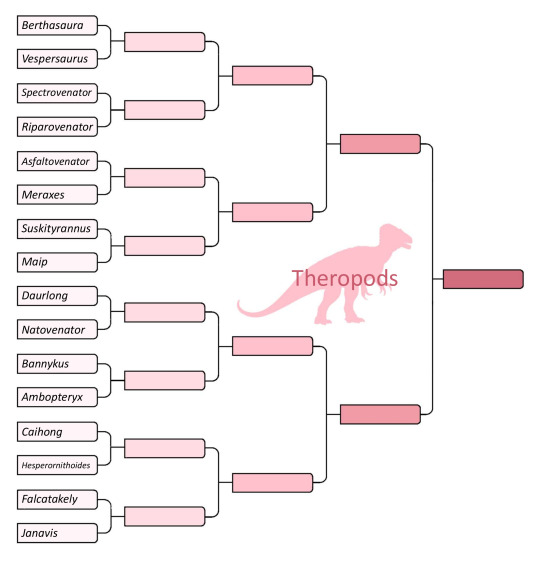
Berthasaura vs Vespersaurus
Spectrovenator vs Riparovenator
Asfaltovenator vs Meraxes
Suskityrannus vs Maip
Daurlong vs Natovenator
Bannykus vs Ambopteryx
Caihong vs Hesperornithoides
Falcatakely vs Janavis
NEORNITHES (BIRDS)

Vorombe vs Prodontopteryx
Asteriornis vs Panraogallus
Anachronornis vs Conflicto
Annakacygna vs Nasidytes
Aviraptor vs Cryptogyps
Miosurnia vs Primoptynx
Danielsraptor vs Heracles
Eofringillirostrum vs Heliothraupis
#dinosaur march madness#dmm#dmm rising stars#palaeoblr#dinosaurs#bracket#polls#march madness#tumblr dinosaur competition#thank you tumblr for making polls dmm is so much easier now I will cry#heliothraupis#eofringillirostrum#heracles#danielsraptor#primoptynx#miosurnia#cryptogyps#aviraptor#nasidytes#annakacygna#conflicto#anachronornis#panraogallus#asteriornis#prodontopteryx#vorombe#janavis#falcatakely#hesperornithoides#caihong
835 notes
·
View notes
Text
Fossil Novembirb: Day 14 - Lost in the Woods

As the global climate was cooling during the Oligocene epoch, tropical rainforests started to shift towards their current distribution in the tropics, and open landscapes such as scrubland was spreading. But that doesn't mean forests were disappearing. In places like Central and Eastern Europe, forests shifted from tropical to temperate. And in these shifting landscapes, birds continued to adapt and diversify.
Turnipax: One of the earliest known members of a relatively obscure bird groups called buttonquails. Despite their quail-like appearance and lifestyle, buttonquails are shorebirds related to gulls and sandpipers.
Palaeotodus: This small insectivore is one of the first known members of the todies, a bird group nowadays restricted to the West Indies.
Primotrogon: An early member of the trogons which had a very different shape compared to its modern relatives, including long wings, a short tail, and relatively small eyes.
Eurotrochilus: The first known true hummingbird, a group now endemic to the Americas, but first appeared in Europe.
Aviraptor: A thrush-sized true hawk with long thin legs and sharp talons, this was a prime predator of small forest birds in the Oligocene.
Wieslochia: One of the earliest known passeriformes, a group that likely evolved in Australia,parts of it's skeleton resemble certain South American passeriforms, like cotingas.
Rupelramphastoides: As the earliest known ramphastid, it was closely related to the barbets as well as toucans, but it bore a closer resemblance to the former.
Oligocolius: A bizarre relative of modern mousebirds that had an appetite for seeds, as the holotype was preserved with seeds in its crop and gullet. It also had a slightly parrot-like beak.
Laurillardia: A distant relative of hoopoes and hornbills, this long winged and long tailed bird used its sharp beak to catch insects.
Rupelornis: A close relative of albatrosses, these seabirds had delicate beaks and long legs. They probably had a similar lifestyle to storm petrels, which carefully pick food from the surface of the water.
#Fossil Novembird#Novembird#Dinovember#birblr#palaeoblr#Birds#Dinosaurs#Cenozoic Birds#Turnipax#Palaeotodus#Primotrogon#Eurotrochilus#Aviraptor#Wieslochia#Rupelramphastoides#Oligocolius#Laurillardia#Rupelornis
46 notes
·
View notes
Text
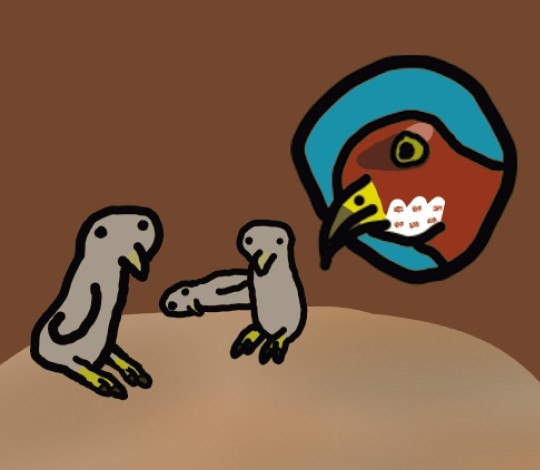
Fossil Novembirb: Day 14
A mother Aviraptor and her chicks
36 notes
·
View notes
Text
The Aviraptor

Fun Fact! - Aviraptors come in a wide range of colors, both in their feathers and the membranes of their wings. The color range of the aviraptor is well documented, especially as the fall season allows researchers to get closer without as much danger of getting maimed. While many of the aviraptor’s features have been studied extensively - from their colors to their intricate behaviors and stunning intelligence - there is one thing that still seems to defy explanation. The Silver Aviraptor isn’t initially all that unusual. While its colors are more muted than would be expected from the species, it still has enough lightness to its markings to fit with the rest of the crowd.
What is unusual is the silver aviraptor’s behavior and legacy. The variant has almost always been documented in a hunting party, and every time it is the leader of these temporary packs. It commands a unique level of respect, never seen in fights and so far not documented as having any scars.
The largest issue comes with the fact that this variant is thought to not even be a variant at all. The silver aviraptor with striking eyes has been sighted for as long as the species has been known. Yet, there has never been a sighting of any more than one individual throughout history. Furthermore, it has evaded direct study as well, seen only in brief moments.
There are two running theories that no one is truly satisfied with. Theory one states that this combination of coloration and behavior is so rare that the chances are that there is only one individual at any given time. Theory two is more exciting, but much less plausible. Perhaps, this ‘variant’ is in fact a single individual, transcending time, that has been alive since the beginning of the species. While the chances of this theory being true are slim, there are those who stand by it simply in the hope that such a thing can be true.
#this one is my favorite#I like the original since red is still my bias#but man#I really like how the colors on this one turned out#I knew I had to give it some mysterious backstory#its only fitting#SeasonalSundays#Fall#Autumn#Aviraptor#raptor#dinosaur#bird#digital art#concept art#creature concept#creature art#animal art#my art
1 note
·
View note
Text
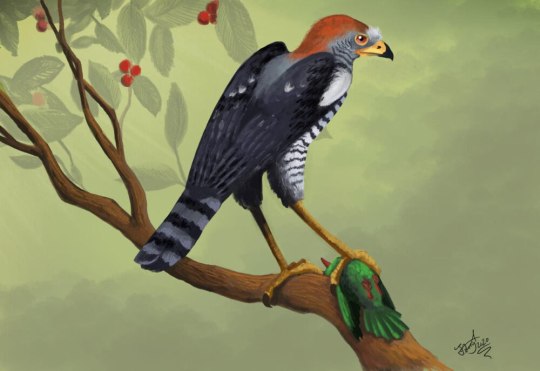
Aviraptor
Aviraptor — викопний рід хижих птахів родини яструбових (Accipitridae), що існував в Європі у пізньому олігоцені (31-30 млн років тому). Викопні рештки птаха знайдено в Польщі (село Ямна Долішня на південному сході країни). Рід містить один вид, Aviraptor longicrus. Його назвали в 2020 році Джеральд Майр (Gerald Mayr) і Йорн Хурум (Jørn Hurum) на основі…
Повний текст на сайті "Вимерлий світ":
https://extinctworld.in.ua/aviraptor/
#aviraptor#oligocene#paleoart#paleontology#палеонтологія#палеоарт#prehistoric#доісторичні істоти#вимерлі тварини#extinct animals#accipitridae#poland#made in ukraine#ukraine#ukraineposts
5 notes
·
View notes
Text
Aviraptor vs Cryptogyps


Factfiles:
Aviraptor longicrus

Artwork by @otussketching, written by @zygodactylus
Name Meaning: Long-legged Bird Thief
Time: 30 to 31 million years ago (Rupelian stage of the Oligocene epoch, Paleogene period)
Location: Jamna Dolna, Menilite Beds, Carpathian Flysch Zone, southeast Poland
Birds of prey are fascinating - there are many different kinds, doing many different things, and their radiation is poorly understood. Aviraptor helps put together some pieces of the puzzle by being the first raptor known adapted for eating birds as prey - essentially, capturing (larger) flying animals in the air, a not-easy feat. It was very similar to modern diurnal raptors, with a short beak, large laws, and long slender legs. That said, with those proportions it was very small - similar in size to living sparrowhawks and tiny hawks. It didn’t have a particularly hooked beak, but a straighter one similar to the harrier-hawks. It was similar, overall, to living birds that hunt early birds - and as such, it is the earliest known bird we know of to hunt other birds (oh bird on bird crime). Living alongside a variety of other birds, including passerines and hummingbirds, it probably fed on smaller avifauna in its area - and Aviraptor itself may have evolved in response to the radiation of many small birds in the early Oligocene. In addition to early modern-hummingbirds and crown passerines, Aviraptor lived alongside hoopoe-hornbill relatives, chickens, fish, and turtles.
Cryptogyps lacertosus

Artwork by @otussketching, written by @zygodactylus
Name Meaning: Powerful Hidden Vulture
Time: 770,000 to 55,000 years ago (Chibanian to Tarantian stage of the Pleistocene epoch, Quaternary period)
Location: Throughout Australia, including Kalamurina, the Wellington Caves, and the Nullarbor Plain
Today, there are no vultures in Australia. In fact, until recently, it seemed fairly clear that no vultures had lived in Australia - but now, we know they did! Originally thought to be an eagle, Cryptogyps was on the small size for a vulture, only bigger than the living Hooded Vulture - though it was about the size of the wedge-tailed eagle. However, it was proportioned similarly to other vultures, and between that and its great range across the entirety of Australia, it is logical to conclude that it lived similarly to other vultures, feeding primarily on carrion and going great distances to find it. It did not have the right musculature to be an active hunter like eagles and hawks. As such, Cryptogyps was a vital part of its environment, reducing the spread of disease and recycling nutrients and energy back into the food web like vultures today. Cryptogyps lived alongside a wide variety of weird megafuana present in Australia during the last ice age, including marsupial lions, giant demon-ducks (mihirungs), giant hippo-sized wombats, sheep-sized and fossorial echidnas, short-faced kangaroos, giant koalas, thylacines, giant maleefowls, huge monitor lizards, large crocodilians, and giant pythons - as well as cassowaries, regular kangaroos, emus, and other large animals that remain today. It was a weird place of which Cryptogyps was a small and important part, and would have been a regular sight in the skies to the first Indigenous Australians to settle on the continent!
DMM Round One Masterpost
#dmm#dinosaur march madness#dmm round one#dmm rising stars#palaeoblr#dinosaurs#paleontology#bracket#march madness#polls#aviraptor#cryptogyps
110 notes
·
View notes
Text
The Aviraptor
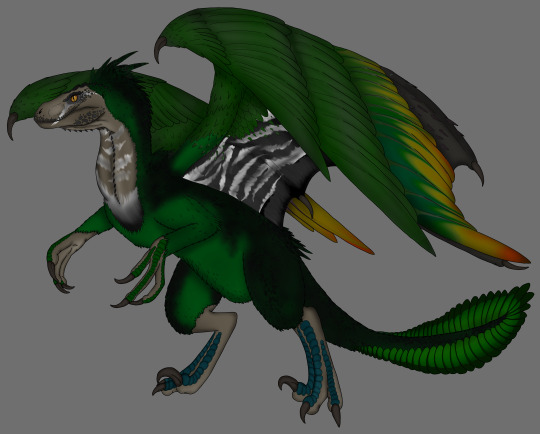
Did you know? - Aviraptor social structure is loose and fluid. While the theropods prefer to hunt alone for small prey, they will occasionally group up to hunt larger creatures together. A flurry of sharp teeth and formidable sickle claws is too much for even large animals to handle. These hunting parties are small, no larger than five individuals at a time. Group dynamics are fluid, with aviraptors coming and going and the current ‘alpha’ changing between hunts. If group sizes get too large, the aviraptors will become territorial and may even begin fighting if they don’t disperse first. Likewise, if a group takes down a prey item they will only share with members of that hunting party. If an outsider comes along, even one that the group has hunted with before, the hunting party will jealously defend their catch.
As temperatures start to cool and leaves start to fall, the aviraptor goes through an interesting behavioral change. The theropod becomes uncharacteristically… agreeable. This mainly comes in the form of their group dynamics, as aviraptor packs become larger and infighting greatly decreases. Because autumn is their mating season, this allows the aviraptors to congregate together to begin mate selection without the risk of fights breaking out between potential partners. Their agreeability means that aviraptors use their brightly colored wings and feathers in dazzling mating displays as opposed to the fighting that they would otherwise employ during the rest of the year. In fact, during fall, their colors will become even more vibrant to increase their chances of finding a mate.
While it makes sense that these aviraptors will become more tolerant of each other during this time, it is their interactions with other creatures that baffle behavioralists. Aside from the small prey that makes up most of their diets, the aviraptors' curiosity for other creatures begins to err on the side of friendliness. This can be unfortunate as, if someone were to be introduced to this species during this time, they may have the misconception that these creatures are curious and amiable. This illusion would be quickly broken if they were to meet these same creatures once the seasons shift again.
Still, there are those who eagerly await the fall season so they can get up close and personal with these dangerous predators. And every year, there are those handful that learn the hard way that, agreeability or not, all predators are capable of showing their true colors if pushed.
#I was goona make this a lot more wild#more vibrant#kinda like the first one#but then I landed on this really nice dark green#so I rolled with it#and frankly#I like how it turned out in the end!#SeasonalSundays#Fall#Autumn#Aviraptor#raptor#dinosaur#bird#digital art#concept art#creature concept#creature art#animal art#my art
0 notes
Text
The Aviraptor
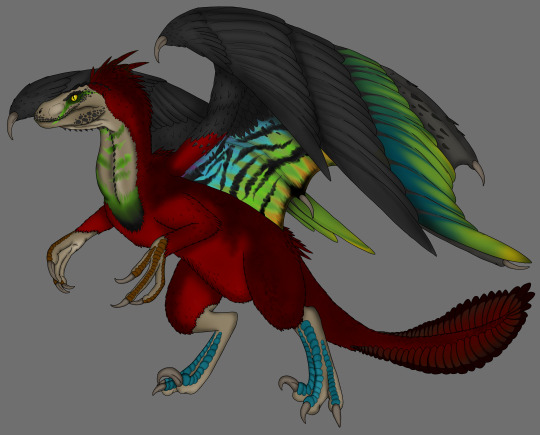
The Aviraptor is another impossible remnant of the past that science has been fascinated with since its discovery. This theropod, true to its dromaeosaurid lineage, is as fast as it is intelligent. Despite the creature’s bright colorations, it is still an ambush hunter as expected for a raptor. The main departure from true raptors is the aviraptor’s large pair of wings. These wings are heavily feathered, but closer inspection reveals that these feathers attach to a leathery membrane, more akin to a bat wing than that of a bird.
Unlike many large, winged creatures, the aviraptor is capable of fully powered flight, though not for any extended period of time. Capable as it may be, the aviraptor still mainly chooses to use these wings as an aid in running. Still, the aviraptor has no trouble scurrying up a tree or cliff and flying to its next destination.
Though the feathers of the aviraptor’s wings help its flight, they are mainly for displays. When the creature loses these feathers, it is still perfectly able to glide and fly. In fact, the aviraptor’s feathers routinely fall off and regrow once a year during autumn. This mandatory molting keeps the feathers strong and healthy.
Even though the aviraptor is a large creature, it has a preference for smaller prey items. This allows the aviraptor to basically run down its prey, overwhelming the smaller animals with lethal efficiency and agility. Prey are as safe in the trees as they are on the ground as the aviraptor is comfortable tearing through foliage and branches. Because of the lift the aviraptor’s wings provide, the theropod spends less energy chasing prey. By choosing small prey, the creature can ensure that it gets food without having to grapple with prey that can potentially harm it. The lift from the wings even allows the aviraptor to run faster and further without tiring, making it a true pursuit hunter.
#Ayy#its another hexapodal prehistoric creature!#we've pretty much covered by favorite dinosaurs now#first spinosaurus and kaprosuchus with the Suchoptera#and now raptors with the aviraptor!#I was thinking about which bird to base it off of#and somehow I landed on macaws#maybe because red is my favorite color and I have a bias#maybe#my big raptor bb#SeasonalSundays#Fall#Autumn#Aviraptor#raptor#dinosaur#bird#digital art#concept art#creature concept#creature art#animal art#my art
0 notes
Text
Fossil Novembirb 14: Lost in the Woods

Eurotrochilus by @iguanodont
Even though parts of the landscape were opening up, the forests of Europe weren't done yet - in fact, many began transitioning to the drier temperate forests we know from Europe today! This transition through the Oligocene would have major consequences for bird evolution - I mean, why else would I bring it up? The formation of the first permanent ice sheets in Antarctica made the world drier, and in turn lead to many of the European Islands of the Eocene connecting with one another, forming an actual continent. Well, sub-continent.
So we saw h ow birds were adapting to the plains - how did they adapt to the temperate forests? Well, by more modern groups appearing, too! In fact, this was a busy period of evolution for most animals, as early forms gave way to modern clades and the early adapations that make those clades unique begin to pop up.

Aviraptor by @otussketching
Eurotrochilus, known from Germany during the Oligocene, is a prime example of this phenomenon: it looks almost identical to living hummingbirds, but - unlike living hummingbirds - it was in Europe, not the Americas! Though it wasn't quite a modern hummingbird, having long finger bones like ancestral forms, it had the adaptations needed for feeding on nectar and hovering while foraging for food. As a pollinator, it would have been a key component of the forest ecosystem, helping to pollinate flowering plants and keeping the forest growing. It was also exceptionally common, and may have lead to many plants co-evolving with hummingbirds in the Eastern Hemisphere - so that when hummingbirds disappeared from the region, the niche was left open for the passerine Sunbirds to one day fill it.
We also start to see more and more flighted birds of prey, like Aviraptor. Though small in size, it had long slender legs and sharp talons, and was thus the first raptor adapted for eating other birds as prey - to capture them in the air mid-flight. Sure, it mainly ate small ones, but we all have to start somewhere! And, with all of those lovely hummingbirds and early passerines and barbets around, it certainly had enough food to eat.
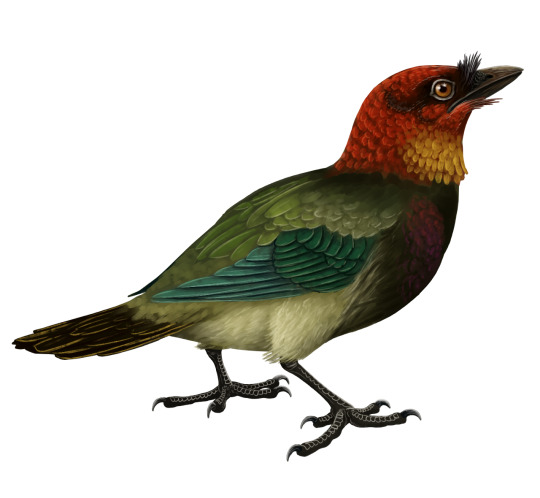
Rupelramphastoides by @drawingwithdinosaurs
Yep, I said barbets - the earliest known barbet-like bird comes from the Oligocene European Forests, Rupelramphastoides. One of the smallest members of the Toucan-Barbet group, it had a lot of very modern traits from the group for its early evolution - including long and slender foot bones like living Toucans! It had a small beak, like barbets, and squat wings for flitting about between the trees. Like its living relatives, it probably ate fruit - which would have been plentiful - as well as insects.
Wieslochia, which I discussed on Passerine day, was also present in these forests - it was just a great place for modern tree-dwelling birds to really get their start! Relatives of hoopoes and hornbills, like Laurillardia, were also present - and had long wings and tails, probably for display in addition to movement. Palaeotodus was present in these forests as well as in the savannah, indicating that it was flexible in its preferred habitat - like the living todies of the Caribbean today. Why todies today are only limited to the Caribbean islands, however, remains a mystery.

Oligocolius by @quetzalpali-art
Mousebirds haven't been limited to their modern range yet, either! Though not a Sandcoelid, Oligocolius was a weird Mousebird with the hooked bill of a modern parrot! So, clearly, Mousebirds were experimenting with lots of different niches prior to the modern day - and this is a neat example of convergent evolution to boot! It had a crop, unlike its living relatives, which allowed it to digest tougher plant material. It was common in its environment, found both in the forests and in more lacustrine and coastal areas, indicating it was flexible in this changing world - an extremely helpful adaptation as the ecosystems evolved!
Primotrogon, an early relative of trogons, breaks the pattern of "Like Modern Relatives but Slightly Off" that we've been seeing with these birds - unlike living trogons, it had long wings, a short tail, and small eyes! In addition to it's weirdness, we actually know the color of this bird - it had green secondary coverts, with grey secondaries and primary coverts, though the color of the primaries is not known. Given the rareness of green in animal colors, but how commonly it comes up in birds, this is another example of that phenomenon!
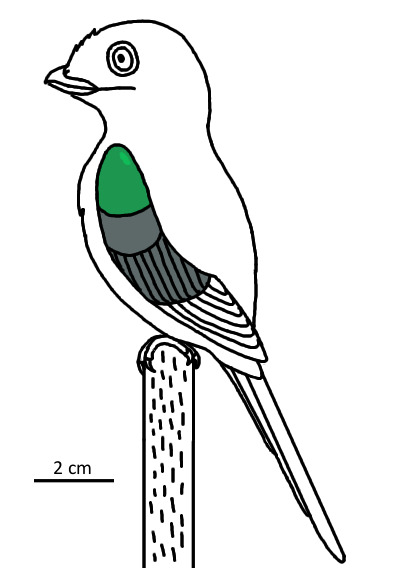
Primotrogon by @albertonykus
Tree dwelling birds aren't the only birds that live in forests, and they aren't the only ones that underwent radiation during this period of environmental change. A weird group of "shorebirds", the Buttonquails, first appears in this ecosystem in the form of Turnipax. Like quails, they are small round ground dwelling birds, but weirdly, their closest relatives are gulls and sandpipers! Turnipax seems to have already been much like its modern relatives, and its possible that the lower diversity of landfowl allowed other avian groups to fill these niches. Rupelornis, a relative of albatross, also lived in the forests of this time - and probably was an ocean going bird, living like modern storm petrels and plucking food carefully from the surface of the water. Like other sea birds, it may have been in forest habitats for the protection - for nesting, rearing young, or other activities. It's a lot easier to hide in the trees than it is to hide at the beach!
This time of environmental turmoil gave dinosaurs new opportunities to diversify - and required flexibility to do so, as the landscape ebbed and flowed between savannah and forest much as it does today. Alas, the climate would not remain stable, and as we continue through the Cenozoic, more and more ecological turmoil will continue to have lasting effects on the evolution of living dinosaurs.
Sources:
Mayr, 2022. Paleogene Fossil Birds, 2nd Edition. Springer Cham.
Mayr, 2017. Avian Evolution: The Fossil Record of Birds and its Paleobiological Significance (TOPA Topics in Paleobiology). Wiley Blackwell.
38 notes
·
View notes